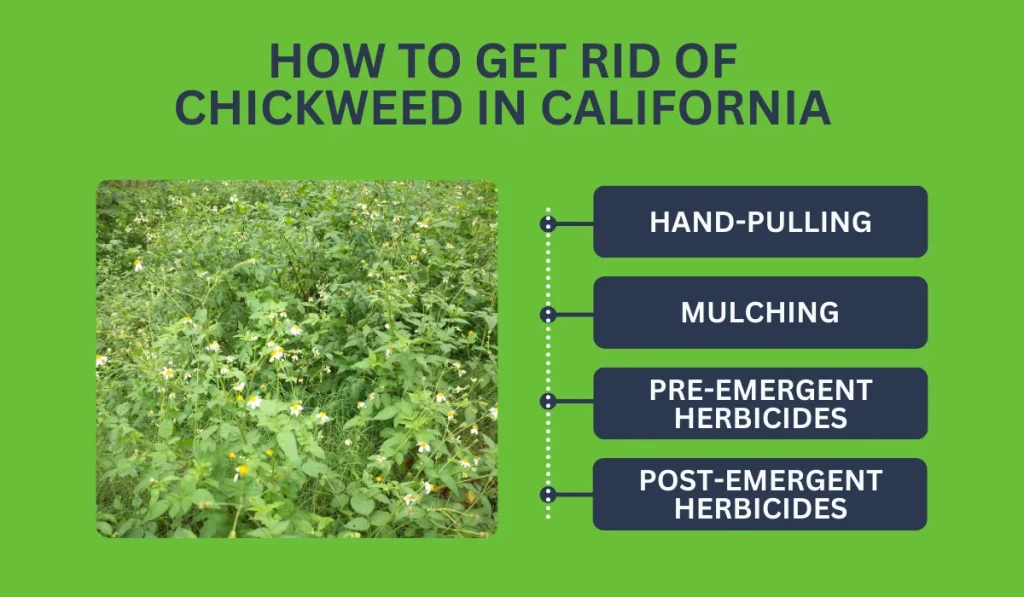Arriving in your backyard only to spot patches of chickweed starting to take over your carefully tended lawn is frustrating. Chickweed is a common invader in lawns, thriving in cool, moist conditions.
Keep reading to learn more strategies for managing and preventing these weeds in lawns.
Key Takeaways
- Chickweed grows in weak grass areas and can be controlled by pulling, mulching, or using herbicides.
- Pre-emergent herbicides stop chickweed seeds from growing, and post-emergent ones kill plants that have already sprouted.
- A healthy, thick lawn can prevent chickweed by following good mowing, watering, and treatment practices.
- Large or hard-to-control chickweed patches may need help from professional lawn care services with special treatments.
How to Get Rid of Chickweed in California

Common chickweeds and mouse-ear chickweeds are annual weeds that take advantage of thin or unhealthy patches in the grass. They often create a dense mat due to their persistent root system and small white flowers.
Addressing it can involve methods that provide specific benefits to different infestation levels.
Hand-Pulling
Hand-pulling targets chickweed directly and is particularly effective for small patches. This method manually extracts the entire plant, including its roots, to prevent regrowth.
When pulling chickweed by hand:
- Pull chickweed after rainfall or watering when the soil is soft for easier removal.
- Wear gloves and use a small gardening tool, such as a trowel, for precision.
- Target young, newly sprouted plants before they produce flowers or seeds.
While hand-pulling can be effective for small patches, regular monitoring and repeated efforts may be necessary, as its roots can regrow if not fully removed.
Mulching
Mulching is a preventative strategy that involves covering the soil to suppress winter annual weeds, like chickweed. It denies light to the seeds, reducing germination chances.
This strategy not only controls chickweed but also improves the lawn environment, making it a win-win solution. When using mulch to control chickweed:
- Choose organic mulches like bark, leaf mulch, or straw for natural control.
- Apply a 2-3 inch layer to smother chickweed and block sunlight effectively.
- Spread evenly around plants and over bare patches, ensuring full coverage.
Pre-Emergent Herbicides
Pre-emergent herbicides are applied before chickweed starts to sprout. These products create a barrier in the soil, preventing seeds from germinating. Applied in early spring or fall, they keep chickweed from appearing in the first place.
Each weed control product contains unique active ingredients. Different application times and methods cater to varying climates and season grass types in your lawn. Consultation with local regulations is recommended before use.
Post-Emergent Herbicides
Post-emergent herbicides target actively growing chickweed. These products are most effective when applied to young broadleaf weeds. Timing and temperature considerations are important for effective control.
Some products contain non-selective herbicides, affecting all plants contacted. Reading labels is important to understand active ingredients and potential impacts on desired turf areas.
How to Prevent Chickweed from Returning
Chickweed is a common lawn weed that can invade lawns when improperly managed. To sustain a healthy lawn from another round of chickweed infestation, here are lawn weed control strategies to use:
- Maintain proper mowing practices for your grass type, like bermuda grass or bluegrass, to limit sunlight to weed seedlings.
- Apply a pre-emergent herbicide in early spring and late summer to prevent chickweed seeds from germinating.
- Mow frequently during the growing season to prevent chickweed from setting seeds and spreading.
- Avoid cutting the grass too short, which can weaken it and create space for chickweed nodes to develop into new plants.
- Water deeply but infrequently to encourage deep-root growth, helping your turfgrass outcompete weeds.
- Conduct regular aeration to improve grass root growth and reduce soil compaction.
- Overseed bare spots with grass seeds to thicken the lawn and prevent chickweed from establishing.



